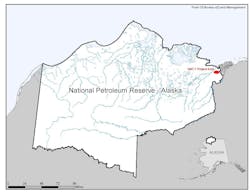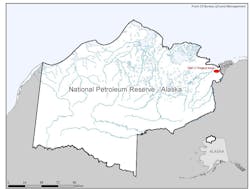The US Bureau of Land Management issued a record of decision (ROD) for the proposed Greater Mooses Tooth One project (GMT1), which cleared the way for the first crude oil production from federal land within the 23 million-acre National Petroleum Reserve-Alaska.
The ROD selected Alternative A, which the US Army Corps of Engineers identified as the least environmentally damaging practicable alternative, BLM said Feb. 13.
“Today’s decision not only opens the way for the first production of oil and gas in [NPR-A], but also provides a new energy source for the Trans-Alaska Pipeline System,” BLM Director Neil Kornze said. “The input of a wide array of stakeholders, especially Alaska native communities, was critical in bringing this project from concept to reality.”
BLM said the plan will provide for as many as 33 development and injection wells on a single well pad. The decision incorporates a robust package of mitigation requirements, including an $8 million contribution from ConocoPhillips Alaska Inc. into a compensatory mitigation fund, it said.
A regional mitigation strategy also will be developed, which will involve input from local native communities, to determine the best uses of the compensatory mitigation funds, BLM noted. It said the ROD also requires implementation of a suite of best management practices to avoid or minimize project impacts.
Project’s specifics
BLM said the project ConocoPhillips proposed would include construction of an 11.8-acre drilling pad in the northeastern NPR-A. It will use elevated pipelines and an electric power line that, when completed, will provide access to both federal and Arctic Slope Regional Corp. (ASRC) oil and gas resources.
Based in Barrow, ASRC was established under the 1971 Alaska Native Claims Settlement Act and incorporated a year later to manage Alaska North Slope native businesses, lands and resources, and investments. With 10,000 employees worldwide, ASRC has been the largest locally owned and operated business in Alaska for the past 17 years, according to its web site.
Janice Schneider, assistant US Interior secretary for land and minerals management, said DOI looks forward to continuing its work with ConocoPhillips as it moves forward on its latest ANS project.
“The strategic planning and mitigation measures agreed to by ConocoPhillips are important as we continue to support thoughtful and balanced development in this region and are critical to compensating for the impacts of this project,” Schneider said.
BLM’s latest action came after it issued a final supplemental environmental impact statement for the GMT-1 project last fall (OGJ Online, Nov. 1, 2014).
Contact Nick Snow at [email protected].
About the Author

Nick Snow
NICK SNOW covered oil and gas in Washington for more than 30 years. He worked in several capacities for The Oil Daily and was founding editor of Petroleum Finance Week before joining OGJ as its Washington correspondent in September 2005 and becoming its full-time Washington editor in October 2007. He retired from OGJ in January 2020.

